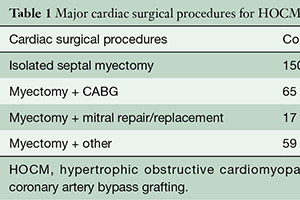Isolated septal myectomy for hypertrophic obstructive cardiomyopathy: an update on the Toronto General Hospital experience
Abstract
Background: Isolated septal myectomy is considered the gold standard for refractory left ventricular outflow tract (LVOT) obstruction at centers with dedicated hypertrophic obstructive cardiomyopathy (HOCM) surgeons. In this paper, we provide an update on the Toronto General Hospital (TGH) experience for isolated septal myectomy and comment on the safety and efficacy of myectomy in patients with thin basal septal thickness at our institution.
Methods: We retrospectively reviewed all patients undergoing surgical myectomy at our institution from January 2012 to August 2016. We analyzed patient characteristics, intraoperative variables, pre- and post-procedural echocardiographic parameters, and key outcomes including post-operative stroke, renal failure, iatrogenic ventricular septal defect (VSD), post-procedure insertion of permanent pacemaker, and mortality.
Results: At our institution, 150 isolated septal myectomy surgeries were performed over the study period. Preoperative echocardiography demonstrated an average basal septal thickness of 2.10±0.43 cm with a resting gradient of 67±37 mmHg and a provoked gradient of 89±40 mmHg. Fifty percent of patients had significant systolic anterior motion (SAM) of their mitral valve and 53% had associated moderate to severe mitral regurgitation (MR). Of note, 24% of patients had a thin septum of ≤1.7 cm. Discharge echocardiograms demonstrated significant septal reduction to an average basal septal thickness of 1.04±0.26 (P<0.05), with negligible resting and provokable LVOT gradients. At the time of discharge, none of the patients had significant SAM and only 5.3% of patients had residual greater than mild MR. Patients undergoing isolated myectomy with a thin basal septum had similar outcomes to those with a >1.7 cm septal thickness. In our contemporary cohort, there were no iatrogenic VSDs, 5.3% of patients required a permanent pacemaker and there was one early death.
Conclusions: Our cohort demonstrates that isolated septal myectomy remains a safe and effective operation that can achieve excellent results, irrespective of basal septal thickness, when done by experienced surgeons in a dedicated hypertrophic cardiomyopathy (HCM) center.
Cover






